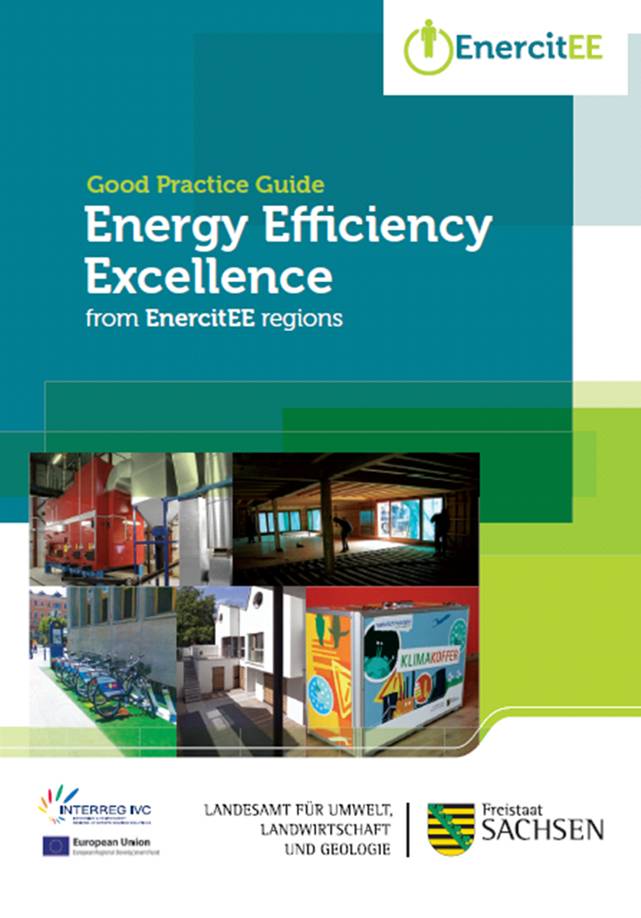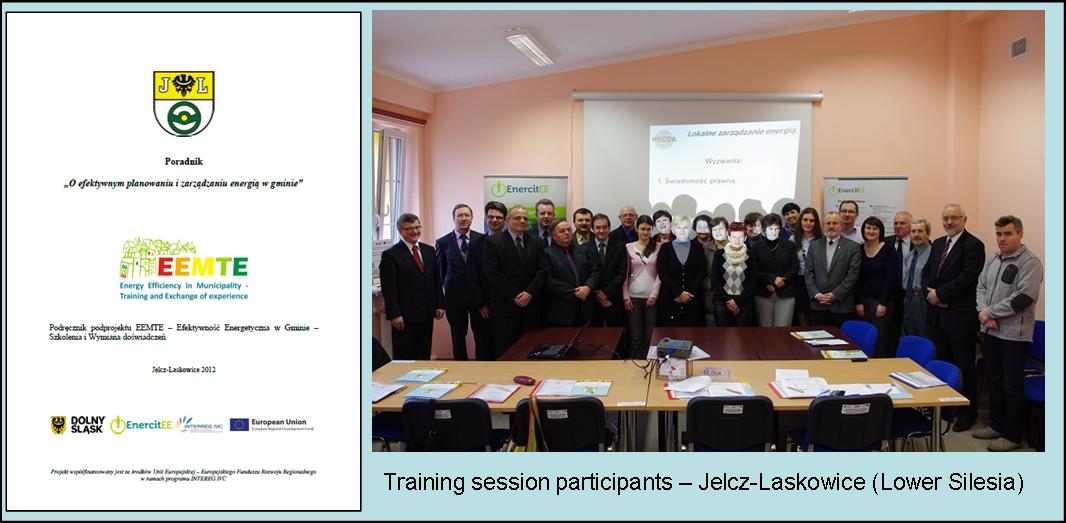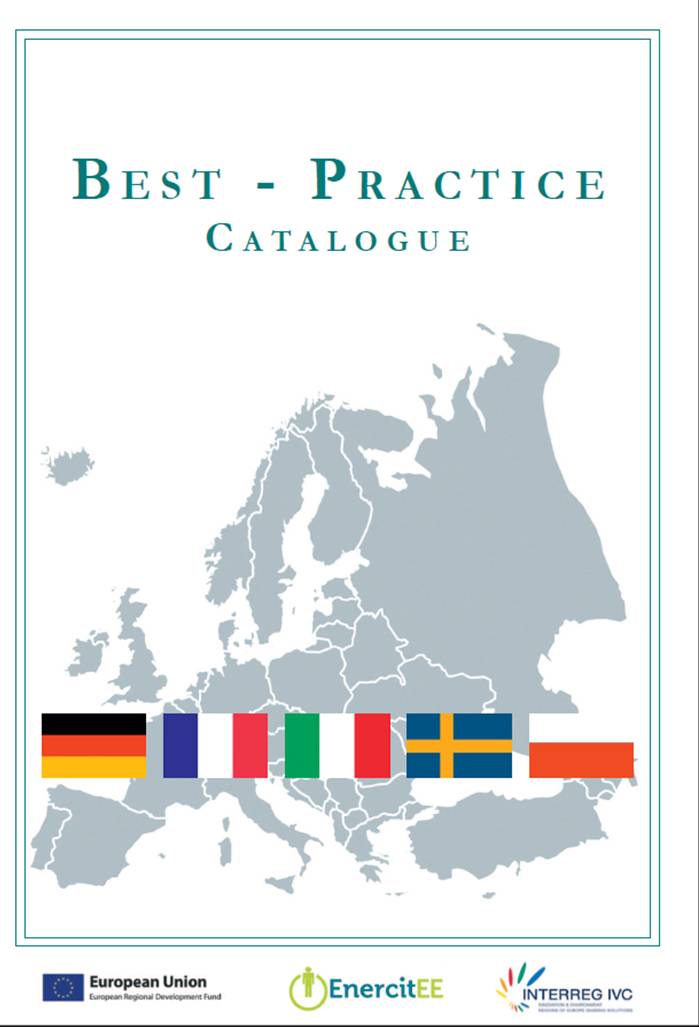Newsletter
- Issue VIII / November 2013
- Issue VII / June 2013
- Issue VI / February 2013
-
Issue V / June 2012
- Editorial: Important milestones have already been reached within EnercitEE
- EnercitEE’s Policy maker exchange – mayors from 4 European countries shared the vision of Växjö
- 2nd EnercitEE symposium
- EnercitEE’s Policy Advice Seminar
- EnercitEE’s Good Practice Guide now available
- First outputs from 1st call sub-projects
- News from EnercitEE’s sub-projects from the 2nd call
- EnercitEE Publicity material
- Upcoming events
- Issue IV / November 2011
- Issue III / July 2011
- Issue II / January 2011
- Issue I / September 2010
Issue V / June 2012
Editorial: Important milestones have already been reached within EnercitEE
Running the Mini-Programme EnercitEE for more than 2 years we can look back on an interesting and successful European journey. Since its start in January 2010 EnercitEE has made some remarkable process. The exchange of experience as core activity of EnercitEE was actively supported by all EnercitEE partners. An important output and result is the jointly developed and finalized Good Practice Guide. It has been developed to demonstrate the energy efficiency potential in the specific areas of competence of the EnercitEE partner regions. It highlights prominent areas of energy efficiency potential, such as buildings, heat/power generation and distribution, transport, innovation and technology, and communication and motivation. In many cases the areas interlink with each other. This shows the need for an integrated planning approach in energy efficiency. Such an approach would make a significant contribution to a sustainable European energy strategy.
Further important milestones within EnercitEE, that fostered the exchange of experience on energy efficiency and climate protection measures, have been three interregional meetings held in the last months. In October 2011 energy experts from all EnercitEE regions met in Wroclaw /Poland for a Policy Advice Seminar. Existing energy efficiency policies and instruments were shared among the partner regions; pros and cons were discussed and the potential for interregional transfer assessed. The 2nd interregional symposium on “Communication and Motivation to increase Energy Efficiency” took place in Annecy/France in February 2012 and dealt with the question how to achieve behavioural change and get cities and citizens actively involved in energy efficiency actions and implement them successfully. The third major event and a premiere within the project was a study trip organised for about 30 mayors from 4 European countries to the City of Växjö/Sweden to learn from “Europe’s greenest city” and their strategy to become fossil fuel free until 2030. This policy maker exchange was thought to inspire participating mayors to test and implement similar strategies and instruments in their communities and counties and also get a chance to exchange experiences with mayors from other EnercitEE regions.
After running successfully two open calls for proposals EnercitEE is financially supporting eleven sub-projects. Half of them are already striving towards the end of their project lifetime in December 2012. So this newsletter proudly presents already achieved outputs and results from 1st call sub-projects and also gives insight information of the progress made in 2nd call sub-projects contributing to the development of energy efficiency measures for citizens and local authorities.
Katharina Mörl, EnercitEE project coordinator
EnercitEE’s Policy maker exchange – mayors from 4 European countries shared the vision of Växjö
“Europe’s greenest city” was host to more than 30 mayors from Poland, France, Italy and Germany from 30 May to 1 June 2012. Learning on the spot and sharing experiences for mayors was a premiere within the INTERREG IVC Mini-Programme EnercitEE. As EnercitEE contributes to the improvement of local and regional policies and provides assistance in the transfer of knowledge on energy efficiency and sustainable transport; the idea was born to organise a 2 ½ day study trip for mayors to learn from the City of Växjö in Smaland/Sweden which represents a shining example for climate protection. Back in 1996 politicians in the municipality decided that Växjö shall become a fossil fuel free city until 2030. Since then the city has worked successfully with environmental and climate issues and has been awarded several times for their remarkable engagement. Since the early 1990s Växjö has reduced its CO2 emissions by 34% which results nowadays in an amount of 3 t CO2/year per capita.
The overall aim of the policy maker exchange was to learn about Växjö and its vision to become fossil fuel free until 2030 and to study exemplary energy efficiency solutions in the fields of transport, heat/cooling generation and –distribution, public participation and future strategies.

Good practice examples were visited followed by a panel session discussing Växjö’s strategy and the impressions taken by the mayors. It revealed that many cities in the EnercitEE partner regions already implemented similar intelligent energy efficiency solutions like Växjö. Further it has to be said that different framework conditions for local authorities in the different countries, for example with regard to tax collection, certain energy efficiency solutions cannot be transferred similarly. Anyway the experiences and impressions gained during the trip inspired the participating mayors to further promote their own energy efficiency strategies in their home countries. Also the exchange of views and strategies especially among mayors from different European regions was well received.
More impressions from the exchange on: flickr.com
2nd EnercitEE symposium
In February 2012 EnercitEE partners met in Annecy/France to exchange experience on “Communication and Motivation to increase Energy Efficiency (EE).” The symposium covered the complex issue and various facets of achieving behavioural change as it is very challenging to motivate citizens and local authorities’ staff to get actively involved into energy efficiency actions and to implement concrete measures. With around 30 participants all members of the Working- and Steering Group as well as representatives from all 11 sub-projects took part in the meeting.

An interesting approach on the involvement of the public and raising awareness of alternative building constructions and materials was presented on a virtual study visit. The Regional Manager of Haute Savoie, Francois Wurtz shared the building process of a low energy house that was accompanied by the media, students and citizens.
Being very experienced in motivating and involving citizens in energy efficiency actions, experts from Haute-Savoie trained the participants on different topics. The French association Mountain Riders informed on its aims, activities and tools on how to communicate energy efficiency and environmental issues to citizens. Christophe Lastennet – external expert of the national energy agency ADEME - provided 8 theoretical steps to achieve behavioural change in general and for energy efficiency programs. To share, compare and discuss the situation in the EnercitEE regions each Regional Partner presented a poster with well known regional & local energy efficiency campaigns and activities that have proved to be successful. Further some EnercitEE sub-projects have been selected to present their experiences on that matter.
For more information on the 2nd EnercitEE symposium go to the document section on the EnercitEE website.
EnercitEE’s Policy Advice Seminar
From 26 to 27 October 2011 energy experts from Saxony, Smaland, Emilia-Romagna, Haute- Savoie and Lower Silesia met in Wroclaw to exchange experiences on various quality management systems, control tools and existing energy planning instruments and policies between the regions and to discuss their pros and cons. In the first part of the seminar experts presented and discussed specific instruments and policies for local and regional energy planning and implementation. The second part of the seminar was characterized by open sessions in which the experts provided suggestions and recommendations to tackle challenges in the regions and/or on the local level.

The summary of the seminar including presentations of the experts, the outcomes of the workshops and policy recommendations have been compiled in a brochure that is available on EnercitEE’s website under the document section. This brochure can serve mayors and other decision makers, energy advisors and staff of climate and environmental protection units as a basis for introducing new strategies, instruments and approaches in their local/regional energy efficiency work and as inspiration for further discussion.
EnercitEE’s Good Practice Guide now available
Experience exchange is the heart of EnercitEE. With the publication of the Good Practice Guide an important milestone has been reached. The brochure compiles shining examples in the fields of energy efficient buildings, heat and power generation and distribution, sustainable transport, innovative technologies and behavioural change. The Good Practice Guide is free of charge and can be downloaded on EnercitEE’s website in English and German (www.enercitee.eu/documents). Soon it will also be available in Italian, Polish and French.

First outputs from 1st call sub-projects
CLIPART is delivering
At the end of 2011 the Initial CLIPART Report was ready, basically in form of a wiki web site (clipartwiki.wikispaces.com).

An edited and more readable version of the ICR is due within June 2012, in the form a pdf file downloadable from the Enercitee CLIPART web page (www.enercitee.eu/CLIPART). By the end of 2012 also the Final Report (the CLIPART Handbook) will be ready and available in English, Italian, German, French and Polish to enhance its circulation in the countries of the CLIPART partners and possibly others. The ICR e.g. contains a collection of 51 examples of existing know-how and best practices about climate change mitigation and adaptation initiatives and/or energy and environmental policies from the five project partners at their level of governance (regions and/or local authorities).
Article in full length on the EnercitEE blog.
LEEAN – Best Practice Catalogue now available
The LEEAN project has compiled a Best-Practice-Catalogue with respectively 3 good practices per partner from 5 European regions. The main focus of presented best practices is the awareness raising of homeowners or tenants concerning energy efficiency. It also includes examples for motivating municipalities to save energy. LEEAN strives to sensitize municipality teams, donors, energy agencies and organizations about energy efficiency.
The Best-Practice-Catalogue is available on the EnercitEE website.
PraTLA – The exchange of students’ experiences between regions is the central focus of PraTLA’s final stage
The Sub-project will end at 31st October 2012. Since the beginning of 2011 until now, approximately 58 practical trainings of students in local authorities in 4 different countries have been carried out and will soon be successfully completed. Students got a first insight into local administrational structures and local authorities learned to set up strategies regarding energy efficiency using the students’ knowledge as energy experts for these tasks. Now, the knowledge gained by the trainings will be transferred to the public and the interregional level. The exchange of experience between the regions in this process is a crucial aspect of all partners. For instance, two Swedish projects carried out by German students were presented at conferences in Saxony and Poland. Further joint events are already planned.

Article in full length on the EnercitEE blog.
RIEEB - energetic investigation in Saxony is almost complete
RIEEB’s main goal is the review and support of the Energy Saving Ordinance (EnEV) in Saxony as well as improving and facilitating the examination and admissibility of construction projects by the responsible construction authority and the qualification of authorized persons. Currently samples of four non-residential buildings in Saxony are being evaluated by external experts. In a summarized total evaluation for each report, results of the individual examination are presented and frequent errors are assessed. In the total evaluation conclusions are made regarding typical errors by using the Energy Saving Ordinance and the calculation of energy demand values. The results will be published in a final brochure and will help other EU-countries to simplify future EU investigations regarding the implementation of energy certificates.

Thermographic investigation of the building envelope Project House MeTeOr University Chemnitz
More results of RIEEB will be political recommendations regarding the achievement of Saxon and European climate protection targets. To reach this goal typical errors concerning complex calculations of the Energy Saving Ordinance as well as discrepancies related to the constructional implementation will be pointed out. Also possibilities for future supervision and the compliance of practicality, workload and reasonableness of the Energy Saving Ordinance will be taken into account. Using this knowledge a plausibility tool for municipal and regional construction authorities and building experts will be developed to evaluate the compliance with the Energy Saving Ordinance. This evaluation tool is expected to be available mid 2013 at the Saxon Energy Agency – SAENA GmbH.
SCC – the sustainable climate challenge – gathered 12 good practices from 4 regions
The goal of SCC is to challenge citizens to become more energy efficient, involving public partners and companies to support them to achieve this challenge. Four main fields are tackled: mobility, energy efficiency, CO2 emissions and behavior change.

SCC partners have gathered a list of 12 good practices on these issues to help people to get and implement new ideas. The SCC good practice list is available on the EnercitEE website.
SustraMM – over 15 000 citizens have been reached by local pilot projects
The SustraMM project focuses on sustainable transports and has already organised 3 training courses for city administrators and stakeholders on carpooling, bicycle and electric bicycles. The city of Cluses/France and Pirna/Germany, as well as the Energy Agency for Southeast Sweden and the Technical University of Dresden have been exchanging experience thanks to two interregional meetings, web meetings and study visits.

Twelve Mobility Management good practices have been identified and are being gathered in a brochure. Over 15 000 citizens have been reached by local pilot projects such as bicycle campaign, new city bus line and the Mobility Week.
Further information: www.enercitee.eu/SustraMM.
News from EnercitEE’s sub-projects from the 2nd call
2nd interregional E-FoxES meeting in Annecy, France
In January 2012 the E-FoxES partnership has held the sub-project midterm meeting. Prioriterre, one of the three sub-project partners hosted the meeting in Meythet/Annecy. The sub-project was reviewed starting with the presentation of the latest project event in the town hall of Bautzen. Prioriterre introduced to the school network involved in the project implementation in Haute Savoie. The third Sub-Project Participant Energikontor Sydost showed some school experiments concerning energy conversions. The partnership agreed about the next steps of the project implementation in the three partner regions. Finally for the study visit the Prioriterre passive house was explained by an expert.

ActEE – 9 communication tools dealing with energy efficiency
Following meetings and exchanges, ActEE’s partners (Mountain Riders, DAPT, Regional Development Agency “ARLEG” S.A.) have chosen 9 communication tools dealing with energy efficiency. One of them, called “Eco Guide to mountain resorts” evaluates resorts actions in terms of sustainable development in France and all over the world according to several themes. This tool facilitates customers’ choice, gives examples of positive actions, and helps professionals to define the scope of sustainability in mountain resorts. All good practices chosen combine positive attitudes, innovative communication tools, people involvement with scientific approaches and contents. The next meeting is planned in October 2012 to optimize the exchange of experiences and further share the knowledge of different communication tools.

GRACE – Analysis of funding programs for citizens and communities
In Germany and especially in Saxony there are many funding programmes which support the energy efficiency of citizens and communities. Within the EnercitEE sub-project GRACE three funding programmes will be analysed in detail. The aim is to find out the effect of the programmes in that way that we are able to make a statement how many CO2 emissions respectively energy is saved with 1 € out of the funding programme. One of the selected programmes is the Saxon Passive house programme. It is part of the Saxon Energy and Climate Protection Programme. During a study visit, organised by Bautzen Innovation Centre, different types of passive houses were visited.

The visited single family passive house in Bautzen is still under construction, but the family is already living there. The flat has an area of 137.5 m². For the future it is planned to install solar panels for producing enough energy for the whole house.
Article in full length on the EnercitEE blog.
EEMTE – New manuals and training concepts for city officials
Manuals, training concepts, seminars and workshops for officials: these are the first results of the EEMTE sub-project. The Commune of Jelcz-Laskowice (Lower Silesia) as the lead partner of EEMTE prepared a guide “On effective planning and management of energy in the commune”.

This guide is a compendium of knowledge on energy efficiency for each employee of local administration and provides the basis for training sessions, lectures and workshops conducted by the project. In various forms training activities in the EEMTE sub-project have been attended by over 200 participants so far – local administration employees from Saxony, Haute-Savoie and Lower Silesia.
FIPREC - 10% of total energy expenditure could be saved
Practically 10% of total energy expenditure could be saved in every community, without any major problems, by using economic investments like Energy-Saving Contracting (ESC). In most cases even more saving is possible. A good German example is the town of Schwabach (population about 39,000) in Bavaria. This commune is saving approximately 130 000 € per year, because major properties have already been modernized by ESC-measures over 10 years ago. Finally, these measures are a very good way for each community to take climate protection seriously. Therefore FIPREC shows current ESC-examples in workshops and will finally illustrate those in a brochure with additional European funding models.

EnercitEE Publicity material
The 4th EnercitEE newsletter is also available in:
Documents available for download
- EnercitEE Good Practice Guide
- Overall summary of Policy Advice Seminar
- Summary and presentations of 2nd EnercitEE symposium
2nd EnercitEE poster series
The EnercitEE poster series has been updated and is now also informing about all 11 sub-projects. If you would like to provide a venue for the exhibition please contact the Regional Managers of EnercitEE.
Upcoming events
23 October 2012
Working Group and Steering Group Meeting in Leipzig, Germany
23/24 October 2012
3rd EnercitEE symposium on ‘Energy efficient buildings and innovation” in Leipzig, Germany

